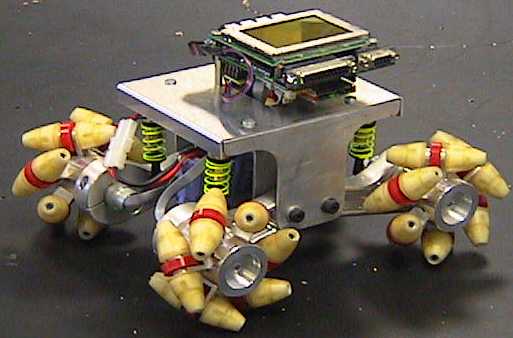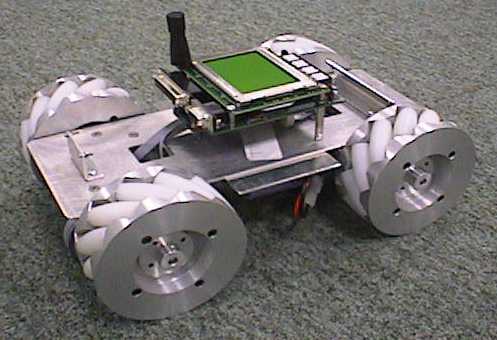
Omni-directional vehicles have a significant advantage over conventional vehicles with car-like Ackermann steering or the differential drive using two independent wheel motors as in Eve and many of our driving robots. Omni-directional driving allows going forward/backward, but also sideways left/right and turning on the spot. This is especially helpful when having to maneuver in a tight environment such as a factory floor.
The EyeBot controller drives 4 independent wheels on the omnidirectional robots Omni-1 and Omni-2. These robots use the "Mecanum" wheel design with free rollers on the wheel surface. Each robot can drive in any direction, i.e. forward/backward, sideways, at an angle, and turn on the spot. The robots are using the EyeBot controller with an add-on module with two additional drivers. For details see the book "Embedded Robotics".
See Omni robot videos.

Omni-1 is the conventional Mecanum wheel design with the rollers held
at the sides. This is a disadvantage when driving on non-smooth surfaces,
because the
rims will make contact with the surface.
Omni-2 uses a new Mecanum wheel design where the rollers are held in
the middle. This gives an advantage when driving on general surfaces, together
with a suspension system that suspends every wheel individually.
Omni-3
Omni-2


TPU 0 front right motor speed TPU 1 front left motor speed TPU 2-3 front left shaft encoder TPU 4-5 front right shaft encoder TPU 6 back right motor speed TPU 7 back left motor speed TPU 8-9 back right shaft encoder TPU 10-11 back left shaft encoder --------- DO 0,1 front left motor direction DO 2,3 front right motor direction DO -,5 back right motor direction DO 6,- back left motor direction